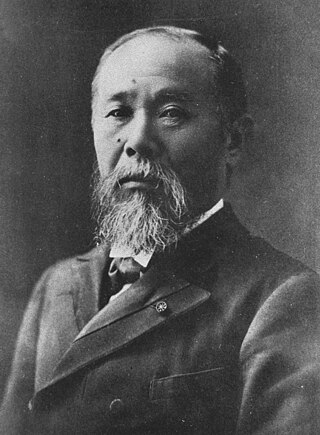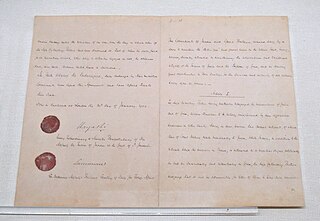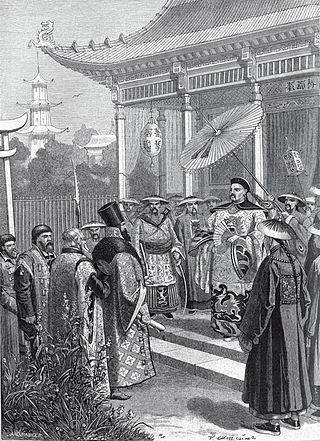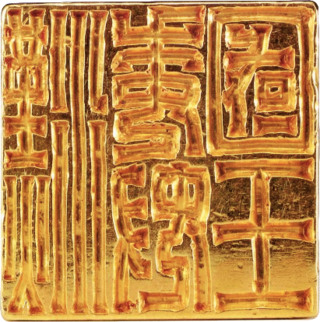Related Research Articles

The Russo-Japanese War was fought between the Russian Empire and the Empire of Japan over rival imperial ambitions in Manchuria and the Korean Empire. The major land battles of the war were fought on the Liaodong Peninsula and near Mukden in Southern Manchuria, with naval battles taking place in the Yellow Sea and the Sea of Japan.

Prince Itō Hirobumi was a Japanese politician who served as the first prime minister of Japan from 1885 to 1888, and later from 1892 to 1896, in 1898, and from 1900 to 1901. He was a leading member of the genrō, a group of senior statesmen that dictated policy during the Meiji era. Even out of office as head of government, Itō continued to wield vast influence over Japan's policies as a permanent imperial adviser (genkun) and frequent president of the emperor's Privy Council. A staunch monarchist and leading proponent of Japan's Westernization, Itō favored a large, all-powerful bureaucracy that answered solely to the emperor, and opposed the formation of political parties.

The Treaty of Shimonoseki, also known as the Treaty of Maguan in China or the Treaty of Bakan in Japan, was signed at the Shunpanrō hotel in Shimonoseki, Japan, on April 17, 1895, between the Empire of Japan and Qing China. It was an unequal treaty and ended the First Sino-Japanese War, in which Chinese land and naval forces were decisively defeated by the Japanese. The treaty was signed by Count Ito Hirobumi and Viscount Mutsu Munemitsu for Japan and Li Hongzhang and his son Li Jingfang on behalf of China.

The First Sino-Japanese War, or the First China–Japan War, was a conflict between the Qing dynasty of China and the Empire of Japan primarily over influence in Korea. In Chinese it is commonly known as the Jiawu War. After more than six months of unbroken successes by Japanese land and naval forces and the loss of the ports of Lüshunkou and Weihaiwei, the Qing government sued for peace in February 1895 and signed the unequal Treaty of Shimonoseki two months later, ending the war.

The Empire of Japan, also known as the Japanese Empire or Imperial Japan, was the Japanese nation-state that existed from the Meiji Restoration on 3 January 1868 until the Constitution of Japan took effect on 3 May 1947. From 1910 to 1945, it included the Japanese archipelago, the Kurils, Karafuto, Korea, and Taiwan. Concessions such as the Kwantung Leased Territory were de jure not parts of the empire but dependent territories. In the closing stages of World War II, with Japan defeated alongside the rest of the Axis powers, the formalized Japanese Instrument of Surrender was issued on 2 September 1945 in compliance with the Potsdam Declaration of the Allies, and the empire's territory subsequently shrunk to cover only the Japanese archipelago resembling modern Japan.

The Liaodong or Liaotung Peninsula is a peninsula in southern Liaoning province in Northeast China, and makes up the southwestern coastal half of the Liaodong region. It is located between the mouths of the Daliao River in the west and the Yalu River in the east, and encompasses the territories of the whole sub-provincial city of Dalian and parts of prefectural cities of Yingkou, Anshan and Dandong.

The Anglo-Japanese Alliance was an alliance between the United Kingdom and the Empire of Japan which was effective from 1902 to 1923. The treaty creating the alliance was signed at Lansdowne House in London on 30 January 1902 by British foreign secretary Lord Lansdowne and Japanese diplomat Hayashi Tadasu. The alliance was the first-ever military pact concluded on equal terms between a Western and non-Western nation.

The Triple Intervention or Tripartite Intervention was a diplomatic intervention by Russia, Germany, and France on 23 April 1895 over the terms of the Treaty of Shimonoseki, imposed by Japan on Qing China at the end of the First Sino-Japanese War. The treaty, signed on 17 April, had ceded the island of Taiwan and the Liaodong Peninsula to Japan. In response, the three Western powers advised Japan to renounce the Liaodong Peninsula on the grounds that it would cause instability; Japan, anxious to keep their goodwill, did so by treaty on 8 November. The Japanese public was outraged, especially after Russia obtained a 25-year lease on the peninsula in 1898. The reaction against the Triple Intervention was one of the causes of the Russo-Japanese War of 1904–1905, in which Japan won the Russian lease on the peninsula.

The Kwantung Leased Territory was a leased territory of the Empire of Japan in the Liaodong Peninsula from 1905 to 1945.
The unequal treaties were a series of agreements made between Asian countries—most notably Qing China, Tokugawa Japan and Joseon Korea—and Western countries—most notably the United Kingdom, France, Germany, Austria-Hungary, Italy, the United States and Russia—during the 19th and early 20th centuries. They were often signed following a military defeat suffered by the Asian party, or amid military threats made by the Western party. The terms specified obligations to be borne almost exclusively by the Asian party and included provisions such as the cession of territory, payment of reparations, opening of treaty ports, relinquishment of the right to control tariffs and imports, and granting of extraterritoriality to foreign citizens.
This article is concerned with the events that preceded World War II in Asia.
History of foreign relations of China covers diplomatic, military, political and economic relations in History of China from 1800 to the modern era. For the earlier period see Foreign relations of imperial China, and for the current foreign relations of China see Foreign relations of China.

Prior to the 17th century, China and Russia were on opposite ends of Siberia, which was populated by independent nomads. By about 1640 Russian settlers had traversed most of Siberia and founded settlements in the Amur River basin. From 1652 to 1689, China's armies drove the Russian settlers out, but after 1689, China and Russia made peace and established trade agreements.

Relations between the Japanese Empire and the Russian Empire (1855–1917) were minimal until 1855, mostly friendly from 1855 to the early 1890s, but then turned hostile, largely over the status of Manchuria and of Korea. The two empires established diplomatic and commercial relations from 1855 onwards. The Russian Empire officially ended in 1917, and was succeeded by Communist rule formalized in 1922 with the formation of the Soviet Union.

The Li–Lobanov Treaty or the Sino-Russian Secret Treaty was a secret and unequal treaty signed on June 3, 1896 in Moscow by foreign minister Alexey Lobanov-Rostovsky on behalf of the Russian Empire and viceroy Li Hongzhang on behalf of Qing China. The treaty and its consequences increased anti-foreign sentiment in China, which came to a head in the Boxer Uprising of 1900.

The century of humiliation was a period in Chinese history beginning with the First Opium War (1839–1842), and ending in 1945 with China emerging out of the Second World War as one of the Big Four and established as a permanent member of the United Nations Security Council, or alternately, ending in 1949 with the founding of the People's Republic of China. The century-long period is typified by the decline, defeat and political fragmentation of the Qing dynasty and the subsequent Republic of China, which led to demoralizing foreign intervention, annexation and subjugation of China by Western powers, Russia, and Japan.

The territorial conquests of the Japanese Empire in the Western Pacific Ocean and East Asia began in 1895 with its victory over Qing China in the First Sino-Japanese War. Subsequent victories over the Russian Empire and the German Empire expanded Japanese rule to Taiwan, Korea, Micronesia, Southern Sakhalin, several concessions in China, and the South Manchuria Railway. In 1931, Japan invaded Manchuria, resulting in the establishment of the puppet state of Manchukuo the following year; thereafter, Japan adopted a policy of founding and supporting puppet states in conquered regions. These conquered territories became the basis for the Greater East Asia Co-Prosperity Sphere in 1940.

The history of China–Japan relations spans thousands of years through trade, cultural exchanges, friendships, and conflicts. Japan has deep historical and cultural ties with China; cultural contacts throughout its history have strongly influenced the nation – including its writing system architecture, cuisine, culture, literature, religion, philosophy, and law.

The history of Japanese foreign relations deals with the international relations in terms of diplomacy, economics and political affairs from about 1850 to 2000. The kingdom was largely isolated before the 1850s, with limited contacts through Dutch traders. The Meiji Restoration was a political revolution that installed a new leadership that was eager to borrow Western technology and organization. The government in Tokyo carefully monitored and controlled outside interactions. Japanese delegations to Europe brought back European standards which were widely imposed across the government and the economy. Trade flourished, and Japan rapidly industrialized. In the late 19th century Japan defeated China, and acquired numerous colonies, including Formosa and Okinawa. The rapid advances in Japanese military prowess led to the Russo-Japanese War, the first time a non-Western nation defeated a European power. Imperialism continued as it took control of Korea, and began moving into Manchuria. Its only military alliance was with Great Britain, from 1902 to 1923. In the First World War, it joined the Entente powers, and seized many German possessions in the Pacific and in China.

The Era of Popular Violence was a series of violent mass protests and riots that occurred in Japan from 1905 to 1918. The Era of Popular Violence is considered to have begun with the Hibiya Incendiary Incident in September 1905 and culminated in the Rice riots of 1918, which lasted from July to September of that year.
References
 This article incorporates text from this source, which is in the public domain ."Japan". Country Studies. Federal Research Division.
This article incorporates text from this source, which is in the public domain ."Japan". Country Studies. Federal Research Division.

